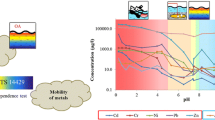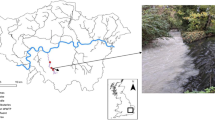Abstract
Dredging simulation by elutriate tests accurately predicted concentrations of Hg, Cu, Mn and Fe released to the water column from contaminated sediment to within 1 order of magnitude. Hg and Cu concentrations increased by up to 7-fold after dredging, but declined to background concentrations within 48 h. Maximum loadings of Hg and Cu coincided with Fe and total organic carbon (TOC) water column concentrations, suggesting Hg and Cu are adsorbed onto particulates of Fe oxides and organic material. Seasonal changes in redox potential and temperature did not significantly affect metal release from sediments. Saline water did not cause significant increases in contaminant release from sediments to the water column over that observed for freshwater. Water quality standards of 1 µg l−1 Hg and 28 µg l−1 Cu as annual averages were not breached by dredging operations. Long-term effects of dredging on Hg and Cu availability, due to deposition of contaminated material as surficial sediments, is, however, of concern.
Similar content being viewed by others
References
Bubb, J. M. and Lester, J. N.: ‘Partitioning and availability of sediment bound metals following final sewage effluent release to a lowland river’, Submitted to Geochim. Cosmochim. Acta.
Bubb, J. M., Rudd, T. and Lester, J. N.: 1991a, ‘Distribution of heavy metals in the River Yare and its associated broads. I. Mercury and Methylmercury’, Sci. Total Environ. 102, 147–168.
Bubb, J. M., Rudd, T. and Lester, J. N.: 1991b, ‘Distribution of heavy metals in the River Yare and its associated broads. II. Copper and Cadmium’, Sci. Total Environ. 102, 189–208.
Bubb, J. M., Williams, T. P. and Lester, J. N.: 1993, ‘The behaviour of Hg within a contaminated tidal river system’, Water Sci. Technol. 28, 329–338.
Blum, J. E. and Bartha, R.: 1980, ‘Effect of salinity on methylation of mercury’, Bull. Environ. Contam. Toxicol. 25, 404–408.
Compeau, G. and Bartha, R.: 1984, ‘Methylation and demethylation of mercury under controlled redox, pH, and salinity conditions’, Appl. Environ. Microbiol. 48, 1203–1207.
Duarte, A. C., Pereira, M. E., Oliveira, J. P. and Hall, A.: 1991, ‘Mercury desorption from contaminated sediments’, Water, Air and Soil Pollut. 56, 77–82.
Edwards, S. C., MacLeod, C. L., Corns, W. T. Williams, T. P. and Lester, J. N.: ‘Determination of organomercury and mercury in environmental samples by flow injection atomic fluorescence spectrophotometry’. Submitted to Internat. J. Environ. Anal. Chem.
Eichenberger, B. A. and Chen, K. Y.: 1980, ‘Methodology for effluent water quality prediction’, J. Environ. Eng. Div. 106, 197–209.
Environmental Standards for List I, II Substances: 1985, in: Dangerous Substances in Water — A Practical Guide, Environmental Data Services, London, 1992, p. 64.
Förstner, U., Ahlf, W. and Calmano, W.: 1989, ‘Studies on the transfer of heavy metals between sedimentary phases with a multi-chamber device: combined effects of salinity and redox variation’, Mar. Chem. 28, 145–158.
Gambrell, R. P., Khalid, R. A. and Patrick, W. H., Jr.: 1980, ‘Chemical availability of mercury, lead and zinc in Mobile Bay sediment suspensions as affected by pH and oxidation-reduction conditions’, Environ. Sci. Technol. 14, 431–436.
Grieve, D. and Fletcher, K.: 1977, ‘Interactions between zinc and suspended sediments in the Fraser River Estuary, British Columbia’, Estuar. Coast. Mar. Sci. 5, 415–422.
Grimwood, C. and McGhee, T. J.: 1979, ‘Prediction of pollutant release resulting from dredging’, J. Water Pollut. Control Fed. 51, 1811–1815.
Goldstone, M. E., Atkinson, C. Kirk, P. W. W. and Lester, J. N.: 1990, ‘Behaviour of heavy metals during activated sludge treatment III, Mercury and Arsenic’, Sci. Total. Environ. 95, 271–294.
Hannan, P. J. and Thompson, N. P.: 1977, ‘Uptake and release of 203Hg by selected soil and sediment samples’, J. Water Pollut. Cont. Fed. 49, 842–847.
Lindberg, S. E., Andren, A. W. and Harriss, R. C.: 1975, ‘Geochemistry of mercury in the estuarine environment’, in: Cronin, L. E. (Ed.), Estuarine Research Volume 1. Chemistry, Biology and the Estuarine System. Academic Press, London, pp. 64–107.
Lindberg, S. E. and Harris, R. C.: 1974, ‘Mercury-organic matter associations in estuarine sediments and interstitial water’, Environ. Sci. Technol. 8, 459–462.
Lindberg, S. E. and Harris, R. C.: 1977, ‘Release of mercury and organics from resuspended nearshore sediments’, J. Water Pollut. Control Fed. 49, 2479–2486.
Longbottom, J. E., Dressman, R. C., Lichtenberg, J. L.: 1973, ‘Gas chromatographic determination of methylmercury in fish, sediment and water’, J. Assoc. Offic. Anal. Chem. 56, 1297–1303.
Ludwig, D. D., Sherrad, J. H. and Amende, R. A.: 1989, ‘Evaluation of the standard elutriate test as an estimator of contaminant release at dredging sites’, J. Water Poll. Control Fed. 61, 1666–1672.
Mierle, G. and Ingram, R.: 1991, ‘The role of humic substances in the mobilization of mercury from watersheds’, Water, Air and Soil Pollut. 56, 349–357.
Mosello, R., Calderoni, A. and Tartari, G. A.: 1989, ‘pH related variations in trace metal concentrations in Lake Orta (Italy)’, Sci. Total Environ. 87/88, 255–268.
National Rivers Authority: 1994, Yare Catchment Management Plan, NRA Anglian Region, Peterborough, U.K., pp. 51.
Osaki, S., Miyoshi, T., Sugihara, S. and Takashima, Y.: 1990a, ‘Adsorption of Fe(III), Co(II) and Zn(II) onto particulates in fresh waters on the basis of the surface complexation model. I. Stabilities of metal species absorbed on particulates’, Sci. Total Environ. 99, 105–114.
Osaki, S., Miyoshi, T., Sugihara, S. and Takashima, Y.: 1990b, ‘Adsorption of Fe(III), Co(II) and Zn(II) onto particulates in fresh waters on the basis of the surface complexation model. II. Stabilities of metal species dissolved in fresh waters’, Sci. Total Environ. 99, 115–123.
Ozoh, P. T. E.: 1991, ‘Volume regulation and accumulation of copper in whole and decapitated Hediste (Nereis) diversicolor under varying salinity — copper regimes’, Water, Air and Soil Pollut. 49, 215–230.
Palermo, M. R. and Thackston, E. L.: 1989a, ‘Test for dredge material effluent quality’, J. Environ. Eng. 114, 1295–1309.
Palermo, M. R. and Thackston, E. L.: 1989b, ‘Verification of predictions of dredged material effluent quality’, J. Environ. Eng. 114, 1310–1330.
Quaghebeur, D., de Wulf, E. and Temmerman, I.: 1989, ‘An inexpensive method for the determination of organic carbon in sludges and sediments’, in: Quaghebeur, I., Temmerman, I. and Angeletti, G. (Eds.), Organic Contaminants in Waste Water, Sludge and Sediment — Occurrence, Fate and Disposal, Elsevier Applied Science, London, pp. 405–409.
Standing Committee of Analysts: 1980, ‘Suspended, Settleable and Total Dissolved Solids in Waters and Effluents’, Her Majesty's Stationery Office, London.
Tanner, C. B. and Jackson, M. L. (1947), ‘Nomograph of sedimentation times for soil particles under gravity or centrifugal acceleration. Proc. Soil Sci. Am. 12, 60–65.
U.S. Army Engineer Waterways Experiment Station, Vicksburg. Technical note EEDP-04-2 (1985).
Wang, J. S., Huang, P. M., Hammer, U. T. and Liaw, W. K.: 1985, ‘Influence of chloride on kinetics of the adsorption of mercury(II) by poorly crystalline Al, Fe, Mn and Si oxides’, Water Poll. Res. J. Can. 20, 68–74.
Wang, J. S., Huang, P. M., Hammer, U. T. and Liaw, W. K.: 1989, ‘Role of dissolved oxygen in the desorption of mercury from freshwater sediment’, in: Nriagu, J. D. and Lakshminrayana, J. S. S. (Eds.) Aquatic Toxicology and Water Quality Management Volume 22 Advances in Environmental Science and Technology., Wiley, New York, pp. 153–159.
Xu, H. and Allard, B.: 1991, ‘Effects of fulvic acid on the speciation and mobility of mercury in aqueous solutions’, Water, Air and Soil Pollut. 56, 709–717.
Author information
Authors and Affiliations
Rights and permissions
About this article
Cite this article
Edwards, S.C., Williams, T.P., Bubb, J.M. et al. The success of elutriate tests in extended prediction of water quality after a dredging operation under freshwater and saline conditions. Environ Monit Assess 36, 105–122 (1995). https://doi.org/10.1007/BF00546784
Received:
Revised:
Issue Date:
DOI: https://doi.org/10.1007/BF00546784




